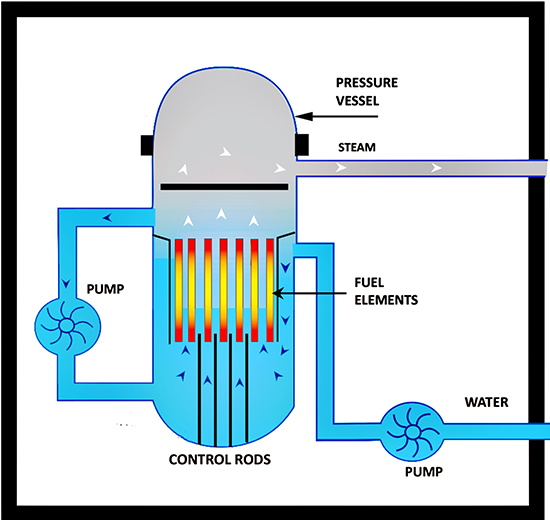
TECHNOLOGY
Generation II
BWR (Boilling Water Reactor)

Source: "Power Reactors - Characteristics. 2010 WNA Pocket Guide", World Nuclear Association, July 2010 [25]
BWR (Boilling Water Reactor) is water cooled and moderate reactor. The BWR construction has many similarities to the PWR. Both are using a light water to cool and moderate reactor and are known as Light Water Reactors (LWRs). But in the BWR water is also a working medium. The BWR is simplifier design of PWR. There is only the single circuit. Water is kept under low pressure, 7 MPa, 2-3 times lower than in PWR, and it can boil directly in the core. Reactor is better cooled but moderating effect and efficiency is decreasing. In the upper part of reactor steam separator and drier are located. Reactor can operate with 12-15% evaporation of water. Steam is produced in the core and passed to turbine. Water around the core is always radioactively contaminated. For that reason biological shield have to contain all devices in reactor circuit so maintenance activity is more difficult. Fortunately, most of the radioactive nuclides are N-16, with half-life period of 7 s. Steam in the core cause decrease in reactor power density by 50% in comparison to PWR, and it is 50 MW/m3. Changing water density cause not equal heating in the vertical axe of core and hence control rods inserted from the bottom of reactor not only regulate level of reactivity but also compensate inequality of power distribution in the core. BWR net efficiency is around of 34 %. It uses enriched fuel in uranium dioxide. An enrichment level is 2,8 % U-235. Lower cost of BWR simpler design is balanced with necessary radiological shields to ensure demanded level of nuclear safety. This type of reactor can follow the load without difficulty and more willingly than PWR. [16],[21],[24],[27]


-
Nuclear power industry|
Technology|
The electricity supply system aspect|
Economics|
Environment|
Public aspect|
Future|
Legislation|
References|